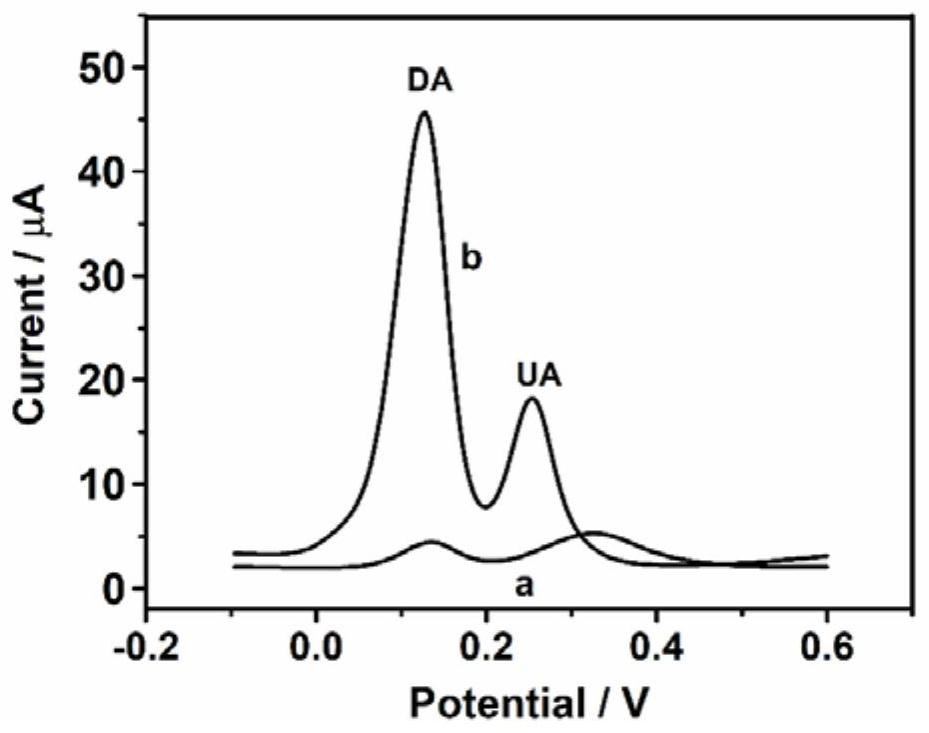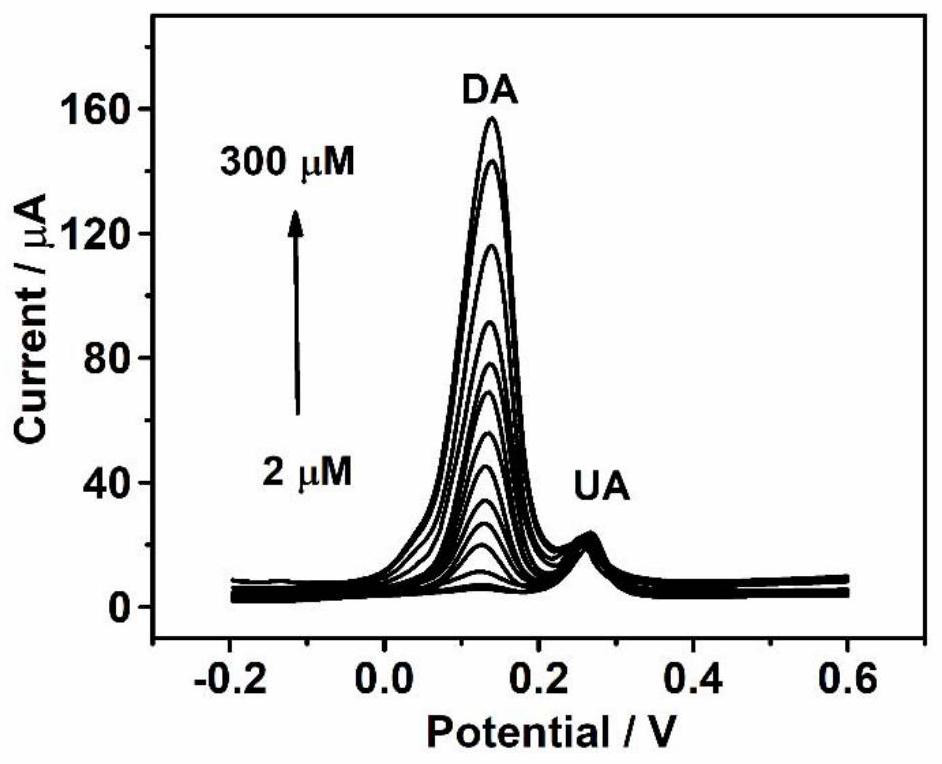Simultaneous detection of dopamine and uric acid based on poly-l-glutathione modified glassy carbon electrode
A glassy carbon electrode and glutathione technology, applied in the field of electrochemical analysis and detection, can solve the problems of narrow linear range, high detection limit, cumbersome preparation steps, etc., achieve good repeatability, less drug consumption, and simple preparation method fast effect
- Summary
- Abstract
- Description
- Claims
- Application Information
AI Technical Summary
Problems solved by technology
Method used
Image
Examples
Embodiment 1
[0026] (1) Use α-A1 of 1.0, 0.3, and 0.05 μm respectively 2 o 3 Polish the glassy carbon electrode, ultrasonically clean it with deionized water after each polishing, and finally dry it with high-purity nitrogen;
[0027] (2) Immerse the glassy carbon electrode in a solution containing 10mM L -In the electrolytic cell of glutathione phosphate buffer solution, deoxygenate with nitrogen;
[0028] (3) Electrochemical polymerization was carried out by cyclic voltammetry, and a three-electrode system was used. The glassy carbon electrode was used as the working electrode, the platinum sheet electrode was used as the counter electrode, and the saturated calomel electrode was used as the reference electrode. The low potential was -1.5V, and the high potential was 2.0V, sweep speed is 100mVs -1 , scanning 12 circles, the obtained modified electrode was rinsed with deionized water, and dried with nitrogen to obtain poly L - Glutathione modified electrodes.
[0029] (4) will gather...
Embodiment 2
[0031] Polymerization in the presence of uric acid L -Glutathione-modified glassy carbon electrode for dopamine detection.
[0032] (1) Use α-A1 of 1.0, 0.3, and 0.05 μm respectively 2 o 3 Polish the glassy carbon electrode, ultrasonically clean it with deionized water after each polishing, and finally dry it with high-purity nitrogen;
[0033] (2) Immerse the glassy carbon electrode in a solution containing 10mM L -In the electrolytic cell of glutathione phosphate buffer solution, deoxygenate with nitrogen;
[0034] (3) Electrochemical polymerization was carried out by cyclic voltammetry, and a three-electrode system was used. The glassy carbon electrode was used as the working electrode, the platinum sheet electrode was used as the counter electrode, and the saturated calomel electrode was used as the reference electrode. The low potential was -1.5V, and the high potential was 2.0V, sweep speed is 100mVs -1 , scanning 12 circles, the obtained modified electrode was rins...
Embodiment 3
[0037] Polymerization in the presence of dopamine L - Detection of uric acid by glutathione modified glassy carbon electrode.
[0038] (1) Use α-A1 of 1.0, 0.3, and 0.05 μm respectively 2 o 3 Polish the glassy carbon electrode, ultrasonically clean it with deionized water after each polishing, and finally dry it with high-purity nitrogen;
[0039] (2) Immerse the glassy carbon electrode in a solution containing 10mM L -In the electrolytic cell of glutathione phosphate buffer solution, deoxygenate with nitrogen;
[0040] (3) Electrochemical polymerization was carried out by cyclic voltammetry, and a three-electrode system was used. The glassy carbon electrode was used as the working electrode, the platinum sheet electrode was used as the counter electrode, and the saturated calomel electrode was used as the reference electrode. The low potential was -1.5V, and the high potential was 2.0V, sweep speed is 100mVs -1 , scanning 12 circles, the obtained modified electrode was r...
PUM
 Login to View More
Login to View More Abstract
Description
Claims
Application Information
 Login to View More
Login to View More - R&D
- Intellectual Property
- Life Sciences
- Materials
- Tech Scout
- Unparalleled Data Quality
- Higher Quality Content
- 60% Fewer Hallucinations
Browse by: Latest US Patents, China's latest patents, Technical Efficacy Thesaurus, Application Domain, Technology Topic, Popular Technical Reports.
© 2025 PatSnap. All rights reserved.Legal|Privacy policy|Modern Slavery Act Transparency Statement|Sitemap|About US| Contact US: help@patsnap.com



